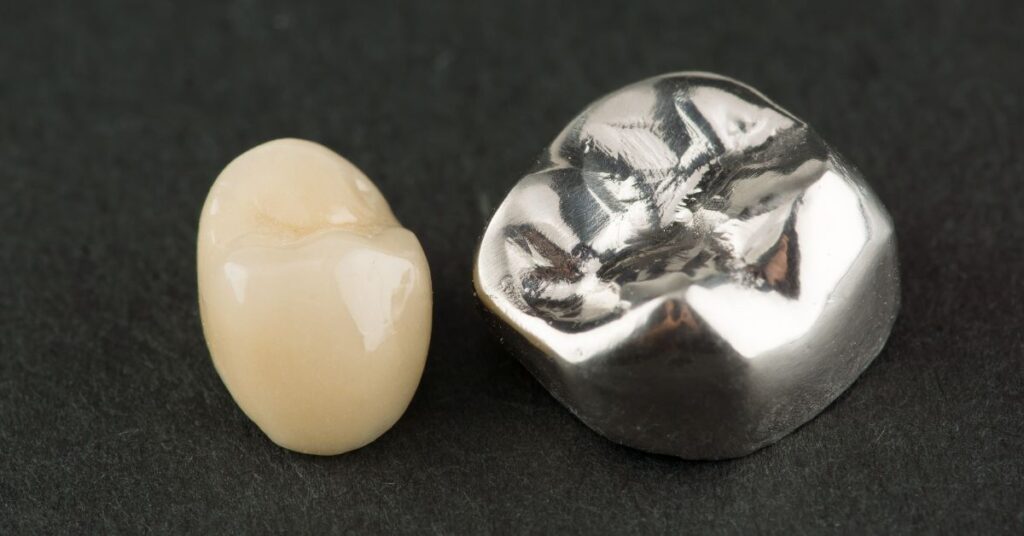Dental Crowns
- Home
- Dental Crowns
Dental Crowns
Dental crowns are a type of dental restoration that is used to restore the function and appearance of a damaged or decayed tooth. Dental crowns are also used to strengthen teeth that are weakened due to various reasons, such as root canal treatment or large fillings. They are essentially a “cap” that is placed over a tooth to cover and protect it.
Dental crowns can be made from a variety of materials, including porcelain, metal, or a combination of the two. Each type of material has its own benefits and drawbacks, which will be discussed in more detail later in this dental crown page.

Types of Dental Crowns
There are several different types of dental crowns, each with its own set of advantages and disadvantages. The most common types of dental crowns are:
Porcelain Crowns: Porcelain crowns are made entirely out of porcelain or a mixture of porcelain and other materials, such as zirconia or metal. They are a popular choice for patients who want a natural-looking crown that blends in with their existing teeth. Porcelain crowns are also very durable and can last for many years with proper care.
Metal Crowns: Metal crowns are typically made from gold, silver, or other metal alloys. They are extremely strong and durable, which makes them a good choice for back teeth that are under a lot of pressure from chewing. Metal crowns are also very long-lasting, with an average lifespan of 20-30 years.
Zirconia Crowns: Zirconia crowns are made from a type of ceramic material that is extremely strong and durable. They are a popular choice for patients who need a crown on a back tooth that is visible when they smile. Zirconia crowns are also resistant to chipping and cracking, which makes them a good choice for patients who grind their teeth.
Composite Crowns: Composite crowns are made from a mixture of resin and other materials. They are a good choice for patients who want a crown that can be made quickly in the dental office. Composite crowns are also relatively inexpensive, which makes them a good choice for patients who are on a budget.
Temporary Crowns: Temporary crowns are usually made from acrylic or other materials that can be easily removed. They are used to protect a tooth while a permanent crown is being made in a dental laboratory. Temporary crowns are not meant to last for a long time and are usually replaced within a few weeks.
What Are Dental Crowns Used For?
Dental crowns are used for a variety of reasons, including:
To protect a weakened tooth: Dental crowns are often used to protect a tooth that has been weakened due to decay, a large filling, or root canal treatment. The crown provides an extra layer of protection and helps to prevent further damage to the tooth.
To restore a damaged tooth: Dental crowns can be used to restore a tooth that has been damaged due to injury or trauma. The crown can be customized to match the shape and color of the surrounding teeth, which makes it look natural.
To cover a dental implant: Dental implants are a popular choice for patients who have lost a tooth. A dental crown can be placed over the implant to create a natural-looking replacement tooth.
To improve the appearance of a tooth: Dental crowns can be used to improve the appearance of a tooth that is discolored, misshapen, or has other cosmetic issues. The crown can be customized to match the color and shape of the surrounding teeth, which makes it blend in seamlessly.
To provide support to a dental bridge: Dental bridges are used to replace missing teeth. A dental crown can be placed on either side of the bridge to provide support and stability.
To protect a tooth after a root canal: After a root canal procedure, a tooth can become weakened and more susceptible to damage. A dental crown can be placed over the tooth to protect it and prevent further damage.
How Are Dental Crowns Made?
The process of making a dental crown typically requires two visits to the dentist. During the first visit, the dentist will prepare the tooth by removing any decay or damaged areas. The tooth will then be reshaped to create room for the crown.
Next, the dentist will take an impression of the tooth and send it to a dental laboratory. The impression is used to create a customized crown that is tailored to fit the patient’s tooth perfectly. In some cases, the dentist may use a digital scanner to create a 3D image of the tooth, which can be used to create a more precise crown.
While the permanent crown is being made, the patient will be given a temporary crown to wear. The temporary crown is usually made from acrylic or another material that can be easily removed.
During the second visit, the temporary crown is removed, and the permanent crown is cemented into place. The dentist will check to make sure the crown fits properly and make any necessary adjustments.
How Much Do Dental Crowns Cost?
The cost of dental crowns can vary depending on several factors, including the type of crown, the materials used, and the location of the dental practice. On average, the cost of a dental crown can range from $800 to $1500 or more.
Porcelain crowns are typically the most expensive, while composite crowns are usually the least expensive. It’s important to note that dental insurance may cover some or all of the cost of a dental crown, depending on the patient’s plan.
Why Do Dentists Use Dental Crowns?
Dentists use dental crowns for several reasons, including:
To protect and strengthen weakened teeth: Dental crowns can be used to protect and strengthen teeth that have been weakened due to decay, trauma, or other factors.
To restore damaged teeth: Dental crowns can be used to restore teeth that have been damaged due to injury or decay.
To improve the appearance of teeth: Dental crowns can be used to improve the appearance of teeth that are discolored, misshapen, or have other cosmetic issues.
To support dental bridges: Dental crowns can be used to support dental bridges, which are used to replace missing teeth.
To cover dental implants: Dental crowns can be used to cover dental implants, which are a popular choice for patients who have lost a tooth.
What Is The Procedure for Getting a Dental Crowns?
The procedure for getting a dental crown typically requires two visits to the dentist. Here is a step-by-step guide to the process:
Consultation: During the first visit, the dentist will examine the tooth and determine if a crown is necessary. X-rays may be taken to determine the extent of the damage.
Preparation: The tooth will be prepared by removing any decay or damaged areas. The tooth will then be reshaped to create room for the crown.
Impression: Next, the dentist will take an impression of the tooth and send it to a dental laboratory. The impression is used to create a customized crown that is tailored to fit the patient’s tooth perfectly.
Temporary Crown: While the permanent crown is being made, the patient will be given a temporary crown to wear. The temporary crown is usually made from acrylic or another material that can be easily removed.
Final Crown Fitting: During the second visit, the temporary crown is removed, and the permanent crown is cemented into place. The dentist will check to make sure the crown fits properly and make any necessary adjustments.
- Follow-up: After the crown is in place, the dentist will provide instructions on how to care for the crown and schedule a follow-up appointment to check on the crown’s fit and overall health.
Types of Dental Crowns.
There are several types of dental crowns available, each with its own unique benefits and drawbacks. The most common types of dental crowns include:
Porcelain Crowns: Porcelain crowns are the most popular type of dental crown. They are made from a ceramic material that closely resembles natural tooth enamel, making them an excellent choice for patients who want a natural-looking restoration. Porcelain crowns are also highly durable and long-lasting.
Metal Crowns: Metal crowns are made from a variety of metals, including gold, silver, and nickel. They are extremely durable and long-lasting but are less commonly used due to their appearance.
Porcelain-fused-to-Metal (PFM) Crowns: PFM crowns are made from a combination of porcelain and metal. The metal provides strength and durability, while the porcelain provides a natural-looking appearance. PFM crowns are a popular choice for patients who want a balance between durability and aesthetics.
Zirconia Crowns: Zirconia crowns are made from a type of ceramic that is extremely strong and durable. They are an excellent choice for patients who need a restoration for a back tooth that is subject to a lot of wear and tear.
Composite Resin Crowns: Composite resin crowns are made from a type of plastic that can be colored to match the patient’s natural teeth. They are a good choice for patients who want a natural-looking restoration but may not have the budget for porcelain crowns.
Dental crowns are a popular dental restoration that is used to protect and strengthen weakened teeth, restore damaged teeth, and improve the appearance of teeth. They are also used to support dental bridges and cover dental implants.
The process of getting a dental crown typically requires two visits to the dentist. During the first visit, the tooth is prepared, and an impression is taken. While the permanent crown is being made, the patient will be given a temporary crown to wear. During the second visit, the permanent crown is cemented into place.
There are several types of dental crowns available, including porcelain, metal, porcelain-fused-to-metal, zirconia, and composite resin. Each type of crown has its own unique benefits and drawbacks, and patients should consult with their dentist to determine which type of crown is best for their needs.
Overall, dental crowns are an excellent option for patients who want to restore damaged or weakened teeth and improve their overall dental health and appearance.
What Type Of Dental Office Does Dental Crowns?
Dental crowns are a common dental procedure that is typically performed in a general or family dental office. These types of dental offices offer a wide range of dental services, including preventive care, restorative dentistry, and cosmetic dentistry.
In some cases, patients may be referred to a specialist, such as a prosthodontist or an endodontist, for the placement of a dental crown. Prosthodontists are dental specialists who focus on the restoration and replacement of missing teeth, while endodontists specialize in treating the inside of teeth, including the pulp and nerves.
However, in most cases, a general or family dentist is qualified to perform the procedure and can provide patients with the necessary care and expertise to ensure the best possible outcome. Patients should consult with their dentist to determine if a dental crown is the best treatment option for their specific dental needs.
Find The Best Family Dental office Today
On The Dental Office Network!

